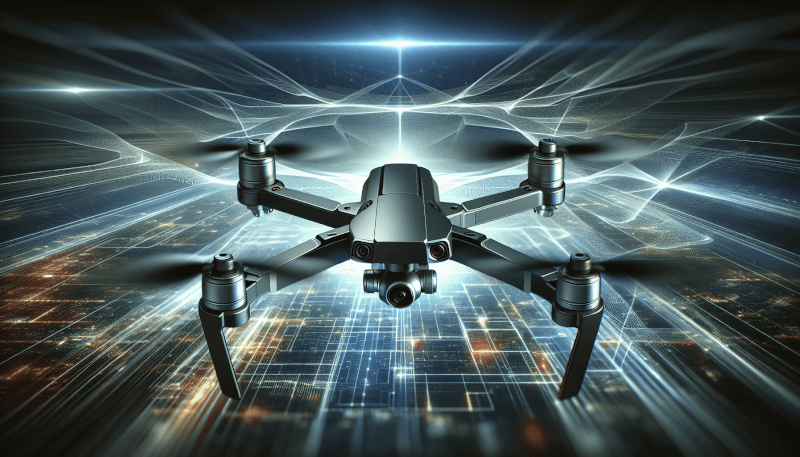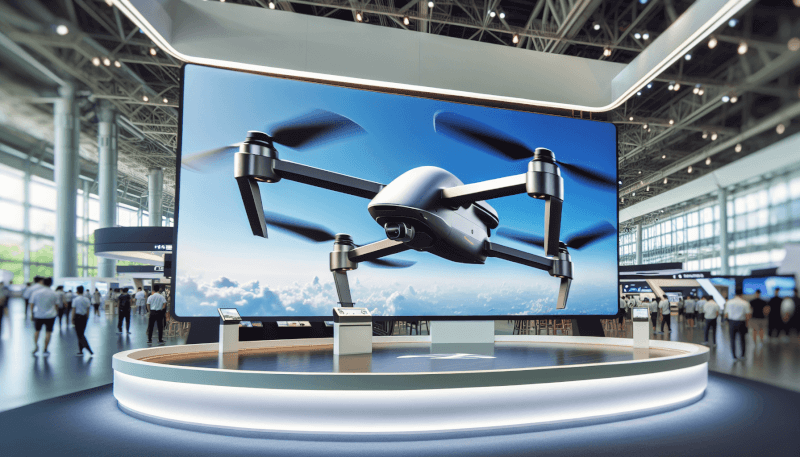Imagine soaring through the skies, effortlessly navigating through breathtaking landscapes and capturing stunning aerial footage. The world of drone technology has witnessed remarkable advancements, revolutionizing the way we explore and capture our surroundings. From cutting-edge obstacle avoidance systems to sophisticated camera stabilization features, the latest innovations in drone technology have elevated the possibilities and capabilities of these remarkable machines. Whether you are an aspiring photographer, an adventure enthusiast, or simply intrigued by the wonders of technology, the advancements in drone technology will leave you awe-inspired and eager to take flight.

Advanced Camera Systems
Drones have revolutionized the world of photography and videography, and one of the key advancements in drone technology can be seen in the advanced camera systems. High-resolution cameras have become increasingly popular, allowing you to capture stunning images and videos with impeccable clarity and detail. Whether you are a professional photographer or simply want to capture amazing moments from a unique perspective, drones equipped with high-resolution cameras can truly elevate your photography game.
Another exciting development in camera technology is the rise of 360-degree cameras in drones. These cameras are capable of capturing panoramic views from all angles, providing a truly immersive experience. Imagine being able to record breathtaking footage of landscapes, events, or even your adventures, all without missing a single detail. With 360-degree cameras on drones, you can capture everything around you and relive those moments as if you were right there again.
Thermal cameras have also made a significant impact in the drone industry. These cameras use infrared sensors to detect and capture thermal energy, allowing you to see heat signatures even in complete darkness. Thermal cameras have a multitude of applications, from search and rescue missions to building inspections. They provide invaluable insights and can be particularly helpful in situations where visibility is limited or when identifying temperature variations is crucial.
Improved Flight Autonomy
As drone technology continues to evolve, flight autonomy has become a major focus. One of the key innovations in this area is obstacle avoidance technology. Drones now come equipped with sensors and intelligent algorithms that enable them to detect and avoid obstacles in their flight path. This feature ensures a safe and worry-free flying experience, especially in complex and crowded environments.
Sense and avoid systems take the concept of obstacle avoidance to the next level. These systems not only detect potential obstacles but also calculate the safest route to avoid them. This advanced technology empowers drones to navigate through any environment with precision and confidence, making them suitable for a wide range of applications, including aerial surveys, inspections, and even delivery services.
Precision landing is yet another impressive enhancement in flight autonomy. Drones equipped with precision landing technology can autonomously land precisely where they took off from or any designated landing area. This capability eliminates the guesswork and potential for error in manual landings, making the drone landing process safer and more efficient, even for novice pilots.
Extended Battery Life
One of the limitations that drone users often face is battery life. However, recent developments have significantly improved the longevity of drone batteries. Long-lasting batteries allow you to prolong your flight time, giving you more opportunities to capture the perfect shot or explore vast areas. With extended battery life, you no longer have to worry about cutting your flight short due to low power.
Furthermore, many innovative drone models now offer swappable battery packs. This means that you can easily replace the depleted battery with a fully charged one, enabling you to continue flying without waiting for the batteries to recharge. Swappable battery packs are particularly useful for professional applications where downtime is costly and time is of the essence.
To complement the advancements in battery technology, smart battery management systems have also been introduced. These systems provide real-time data on battery health, charge levels, and estimated flight time, allowing you to optimize your flights and ensure a safe return. With smart battery management, you can fly with confidence, knowing exactly when it’s time to return and recharge.
Foldable and Portable Designs
One of the most appealing aspects of drones is their ability to capture perspectives that were previously impossible or difficult to obtain. However, the convenience of drone portability has often been a concern. Fortunately, manufacturers have addressed this by introducing compact and foldable drones. These drones can be easily folded and packed into a small case, making them incredibly portable and convenient to carry on your adventures.
In addition to foldable designs, lightweight materials have been incorporated into drone construction. This not only contributes to the portability factor but also ensures that the drones remain agile and responsive during flight. Whether you are hiking, traveling, or simply heading out for a quick aerial photography session, lightweight drones make it easy to bring your gear along without adding considerable weight to your backpack.
To further enhance the portability aspect, easy-to-carry cases have become a popular accessory for drone users. These cases are specifically designed to accommodate various drone models, providing a secure and organized way to transport your drone and its accompanying accessories. With easy-to-carry cases, you can confidently take your drone anywhere and capture stunning footage wherever your adventures take you.

Increased Payload Capacity
The ability to carry heavier payloads is an essential feature for many professional drone applications. Whether it’s delivering packages, conducting scientific experiments, or even capturing high-quality aerial footage with specialized cameras, drones with increased payload capacity can handle the task with ease. Thanks to advancements in drone engineering, you can now unleash your creativity and explore new possibilities with heavier payloads.
Specialized payload options have also emerged, allowing drones to cater to specific industry needs. For example, drones equipped with thermal cameras and LiDAR sensors are commonly used in aerial inspections and mapping applications. These specialized payloads provide valuable data that cannot be captured by traditional cameras alone, opening up new opportunities in various industries.
Furthermore, enhanced stability for payload delivery has been achieved through advancements in drone design and flight control systems. This stability ensures that payloads are delivered accurately and safely, even in challenging weather conditions or demanding environments. By having the capability to carry heavier payloads and maintain stability, drones are becoming indispensable tools for a wide range of commercial and industrial applications.
Improved Remote Control
The remote controller is an essential component of the drone piloting experience, and recent advancements have significantly improved its functionality and usability. Intuitive and ergonomic controllers now offer a more comfortable and natural grip, reducing fatigue during prolonged flight sessions. Whether you are a professional pilot or a recreational user, an intuitive remote controller can enhance your overall flying experience.
Advanced haptic feedback is another key development in remote control technology. These feedback systems provide tactile sensations in response to different flight conditions, such as changes in altitude or velocity. By incorporating haptic feedback, remote controllers offer a more immersive and intuitive flying experience, allowing you to feel connected to your drone and have greater control over its movements.
Many modern drones also come equipped with built-in screens on their remote controllers, eliminating the need for separate devices such as smartphones or tablets. This integration streamlines the piloting process, providing a convenient and straightforward way to access important flight information and camera feeds. Additionally, smartphone compatibility still remains a common feature, allowing users to connect their devices for an enhanced and personalized piloting experience.

Intelligent Tracking and Follow Modes
Gone are the days when you needed a dedicated camera operator to capture dynamic footage of moving subjects. With intelligent tracking and follow modes, drones can now autonomously track and follow a specified target or subject. Active subject tracking uses advanced computer vision algorithms to identify and track subjects in real-time, ensuring that they remain in the frame while the drone moves and adjusts its position.
Gesture-based control is another exciting innovation that has revolutionized the way we interact with drones. Using simple gestures, you can command your drone to perform specific actions, such as taking off, landing, or capturing a photo. This hands-free control feature adds a fun and interactive element to your drone piloting experience, making it accessible and enjoyable for users of all skill levels.
Automatic flight path algorithms have also become increasingly sophisticated. Drones can now plan and execute complex flight paths without the need for manual intervention. This feature is particularly useful for capturing cinematic shots or creating professional-grade aerial videos. With automatic flight path algorithms, you can focus on framing your shot and let the drone navigate through the designated flight path with precision and accuracy.
Enhanced Safety Features
Safety is a top priority in the world of drones, and manufacturers have implemented various features to ensure safe and responsible drone operations. Geofencing and no-fly zone limitations are integral in preventing drones from flying into restricted areas, such as airports or government facilities. These features utilize GPS technology to create virtual boundaries that restrict the drone’s flight, minimizing the risk of unauthorized and potentially dangerous operations.
Return-to-home functions have also become a standard safety feature in drones. In the event of signal loss, low battery, or manual recall, drones will automatically return to their takeoff point or a pre-programmed safe location. This provides peace of mind, knowing that your drone will return safely even if unforeseen circumstances occur during the flight.
Emergency landing systems are another essential safety feature that ensures the well-being of the drone and those around it. In the event of a critical malfunction or loss of control, drones equipped with emergency landing systems will execute a controlled landing procedure to prevent damage or injury. These systems are designed to protect both the drone and individuals in the vicinity, further enhancing the safety aspect of drone operations.

Artificial Intelligence Integration
Artificial intelligence has revolutionized various industries, and the drone industry is no exception. Object recognition and tracking capabilities have been integrated into drones, enabling them to automatically identify and track specific objects or subjects. This feature is especially useful in applications such as search and rescue missions or monitoring wildlife, where identifying and tracking moving objects is crucial.
Autonomous flight modes have also been enhanced with the integration of artificial intelligence. Drones can now perform predefined flight patterns, such as circular orbits or figure-eight trajectories, without requiring continuous manual control. This automation simplifies the flight process and allows for precise repetition of shots or monitoring tasks, saving time and effort for the operator.
Real-time data analysis has become a valuable asset in drone operations. With artificial intelligence, drones can analyze and interpret data collected during flight, providing valuable insights and actionable information. Whether it’s analyzing crop health, identifying structural defects in buildings, or detecting anomalies in large-scale infrastructure, real-time data analysis empowers drones to contribute to decision-making processes and drive efficiency in various industries.
Improved Connectivity and Range
To maximize the potential of drones, connectivity and range have been significantly improved in recent years. Long-range transmission capabilities allow you to control and communicate with your drone from a considerable distance. This is particularly useful when flying in remote areas or when you need an extended flight radius to cover larger areas.
Enhanced Wi-Fi and 5G connectivity have also improved the overall performance and reliability of drones. With faster and more stable connections, you can experience smoother video streaming, real-time data transfer, and seamless control inputs. These connectivity advancements have paved the way for more sophisticated applications and improved the overall user experience.
Multiple communication frequency options have also been introduced to cater to different environments and regulations. From the traditional 2.4 GHz frequency to the less congested 5.8 GHz frequency, users now have the flexibility to choose the optimal frequency for their specific location and ensure uninterrupted communication with their drones. This ensures reliable connectivity and minimizes the risk of signal interference, resulting in a more reliable and efficient flight experience.
In conclusion, the latest innovations in drone technology have transformed the way we capture images and explore the world from above. From advanced camera systems to enhanced flight autonomy, extended battery life to foldable and portable designs, and improved remote control to intelligent tracking and follow modes, drones have become more powerful, versatile, and user-friendly than ever before. With a focus on safety, artificial intelligence integration, and improved connectivity and range, drones are opening up new possibilities in various industries and providing countless opportunities for creativity and innovation. So, whether you are a professional photographer, videographer, surveyor, or simply a drone enthusiast, these advancements offer an exciting future for the world of drone technology.



